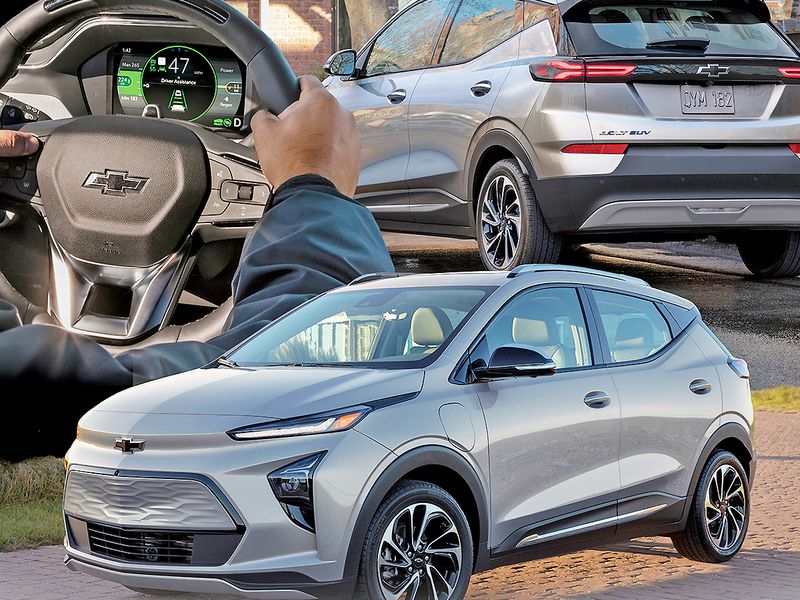
DETROIT — At first glance, it can be tough to see much difference between the Chevrolet Bolt EV and its new crossover variant, the Bolt EUV, even though General Motors says the two electric vehicles have no exterior sheet metal in common.
But GM thinks it has differentiated the EUV from its smaller sibling just enough to address some of the shortfalls that have held back the Bolt EV. The EUV is 6 inches longer and has 3 inches of additional rear legroom, a change Bolt EV customers had requested, said Jesse Ortega, the vehicles’ executive chief engineer. According to GM’s specs, the front seats and cargo areas are almost exactly the same size.
It’s a strategy that has worked for GM recently with the Buick Encore and Encore GX and the Chevy Trax and Trailblazer. Chevy also has successfully sold the Tahoe alongside the longer-wheelbase Suburban for a quarter century. In each case, the automaker effectively divided one segment between two entries from the same brand.
“With the continued shift away from cars, when you look at the segments … in these broad groups, there is room at the two ends of the spectrum for vehicles that are technically in the same segment but go after a slightly different buyer. This is the fragmentation of the marketplace,” said Jeff Schuster, president of global forecasting at LMC Automotive. “You’re trying to give consumers what they want and keep them in your brand.”
The Trailblazer and Trax held a combined 15.8 percent of the subcompact crossover segment in 2020, compared with 13.7 percent share for the Trax alone in 2019, according to the Automotive News Research & Data Center. And the Encore GX — 3 inches longer and at least $1,000 more — already supplanted the Encore as Buick’s top seller in 2020, its first year on the market.
Despite their similarities, Chevy believes it can sell more of the Bolt EV and EUV combined than it could have sold with the car version alone, said Steve Majoros, vice president of Chevy marketing. The EUV starts at $2,000 more than the freshened EV, though both have lower sticker prices than the 2021 Bolt EV.
“If you want something a little smaller, more on the value side, the revamped Bolt EV is perfect for you. If you had been in a Bolt EV and maybe you want something bigger or different, we’ve got that great variant for you as well,” Majoros said.
“It is fully our intention to grow with these two products.”
For too long the industry has been broken into wide segments labeled small, medium or large, said Sam Fiorani, vice president of AutoForecast Solutions.
When Chevy introduced the Tahoe, “it seemed like it should encroach on Suburban territory, but it is distinctly a different size and appeals to a different buyer. That’s the same way with their whole crossover lineup. The Trax is smaller than the Trailblazer, which is smaller than the Equinox,” he said. “These fit in distinct niches, just like traditional sedans and hatchbacks had.”
At $31,995 for the smaller Bolt and $33,995 for the EUV, the Bolts cost significantly less than GM’s upcoming EVs: the 2022 Cadillac Lyriq and the six-figure 2022 GMC Hummer.
The Hummer and Lyriq will be built on GM’s more expensive proprietary Ultium battery architecture, while the Bolts are built on the automaker’s previous-generation EV architecture.
The Bolts, less stylized and technology-rich than the Lyriq and Hummer, are more likely to bring mainstream buyers to the EV market quickly, Schuster said.
“You do need to get scale,” he said. “In order to do that and attract more buyers, this is another rung in their strategy.”
Chevy’s creation of a longer Bolt variant is similar to Tesla’s rollout in the EV segment, Fiorani said.
“It makes sense to make a derivative of your first EV, just like Tesla took the Model S and made the Model X. Making a Bolt and a longer Bolt makes sense before you go and invest in all-new platforms and 10 different sizes and three different body styles,” he said. “It makes much more sense when the market hasn’t fully filled out and the buyers haven’t really stepped up yet.”
The Lyriq and Hummer likely will be built in low volumes at first, and they will be ordered through a reservation system rather than a traditional dealership allocation model, whereas Chevy will distribute the Bolts to dealers the same way it allocates gasoline-powered vehicles.
In many markets, EV sales are low or nonexistent, but Chevy says it’s determined to sell Bolts in all 50 states.
“Eventually, the only way for the industry and for GM and Chevrolet to be successful is to have the right entries at the right price point across the [price] curve in segments that customers are looking for,” Majoros said.
“I think our approach is the right one. It’s more about … giving customers choice in the places that we need it. From a Chevrolet standpoint, we’re always going to be rooted in value and customer choice.”

